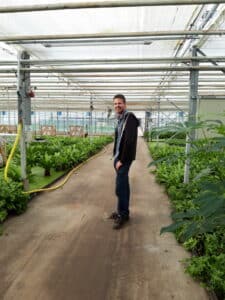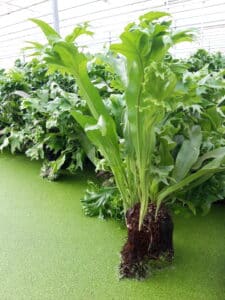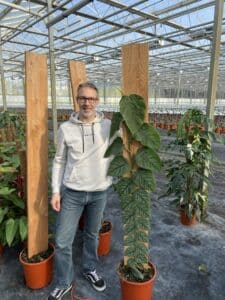Kwekerreportage: Kwekerij Zeur Niet

I start by asking him where the name ‘No Moaning’ originated.
There used to be four nurseries here on the same lane, all run by people from the Scheffers family and all calling themselves ‘Scheffers Nursery’. That was asking for trouble, and unsurprisingly goods were often delivered to ‘the wrong Scheffers’. One day, my dad was talking to a supplier who couldn’t hide his frustration about the situation. My dad said, there and then, ‘Sorry about that, from now on we’ll be the No Moaning Nursery.’
He then got a sign and adhesive letters, and put it up with the new name the very same day. That was my dad, always up for a joke. However, the name stuck almost immediately. We’re proud of our name No Moaning anyway. It suits us, as we like to get stuck in, without drama. It’s also reflected in our slogan: Just let it grow! It’s a play on the words ‘just let it go’, another reference to ‘no moaning’. However, it also refers to our favourite pastime; trying things out. If we come across a potential new plant, we find it a place in the nursery and keep an eye on how it does.
So you are true pioneers?
Well the thing is, we’re only a small nursery without high-end automation. We’re unable to compete with large nurseries in the standard plant segment, so we have to take a different approach. We experiment with everything, and never fail to come up with something new. You may have heard of us through Castanospermum, Snaily and Lova, for example.
What’s the story behind Lova?
The full name is ‘Lova, life on lava’. These plants live on black lava rock, clinging on with their roots. The lava gives the plants something to grasp on to, as well as moisture and nourishment. Another obvious advantage is the decorative aspect.
The idea originated with a grower we know well in Australia. We tried it out here, and received lots of positive comments. Basically, we start off with pieces of lava with a blind hole in the top and a flat base. We place a cutting in the hole of the stone. Then we place the stones with cuttings in a part of our greenhouse where there’s a permanent layer of water. The plants grow and envelop themselves around the stone, until they’re big enough to be sold. At this point, we put the plants and stone in a decorative tray, so the consumer can also leave them in a layer of water.
We also have a number of XL Lovas, real show models. A tip for garden centres; use one XL plant in the Lova presentation, it really draws attention. Garden centres which follow this advice will also have to regularly order new show models, because these XL plants will fly off the shelves.

This is the Epipremnum albo variegata. We can’t speak highly enough of this white variegated plant. Over here are some that are slightly older, where you can see that the holes in the leaf have grown into large notches. When mature, you suddenly realise that it looks very much like a white-variegated Monstera. However, the advantage of the Epipremnum is that it does better in the living room. The same can’t be said about the white variegated Monstera, while the Epipremnum does well even during the winter!
Our other showpieces are the flat-growing Raphidophoras and Monstera dubia. You can see how the leaf creeps up against the shelf. We even have a number of XXL plants for the enthusiast. Following its success with the moss pole, Kratiste has also developed a biodegradable alternative for planks. We’re now using it to grow plants for the first time, and the results are excellent.
What are your plans for the future?
At some point, my dad will retire. (At the very moment Tom says this, his father Jos just happens to pass by.)
Tom: ‘We were just talking about you turning 64 this year.’
Jos: ‘That’s right, I’m looking forward to one more free afternoon a week. But I’ll miss being a bother to you and your brother every day.’
In any case, we’ll carry on discovering beautiful plants that are suitable for our nursery. My brother Stef went to Asia in January, where he visits our contacts on a regular basis.
I handle the administrative and sales side of things. These days, you have to make sure that everything is registered properly in the IT systems, but I also really enjoy personal contact. That contact is really important, but it’s hard to build a relationship with people who only send digital orders. Javado is one of those companies that’s easy to call when I’ve got something interesting to offer. Not everything has to be automated. No moaning, just a nice bit of personal contact from time to time.
Published on: 22 Maio 2023